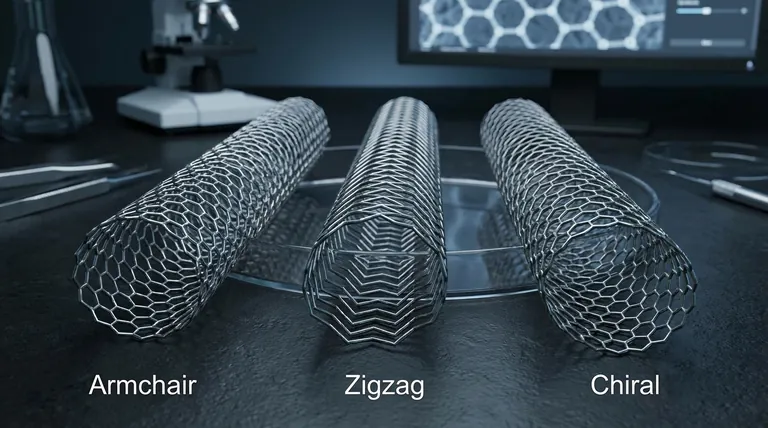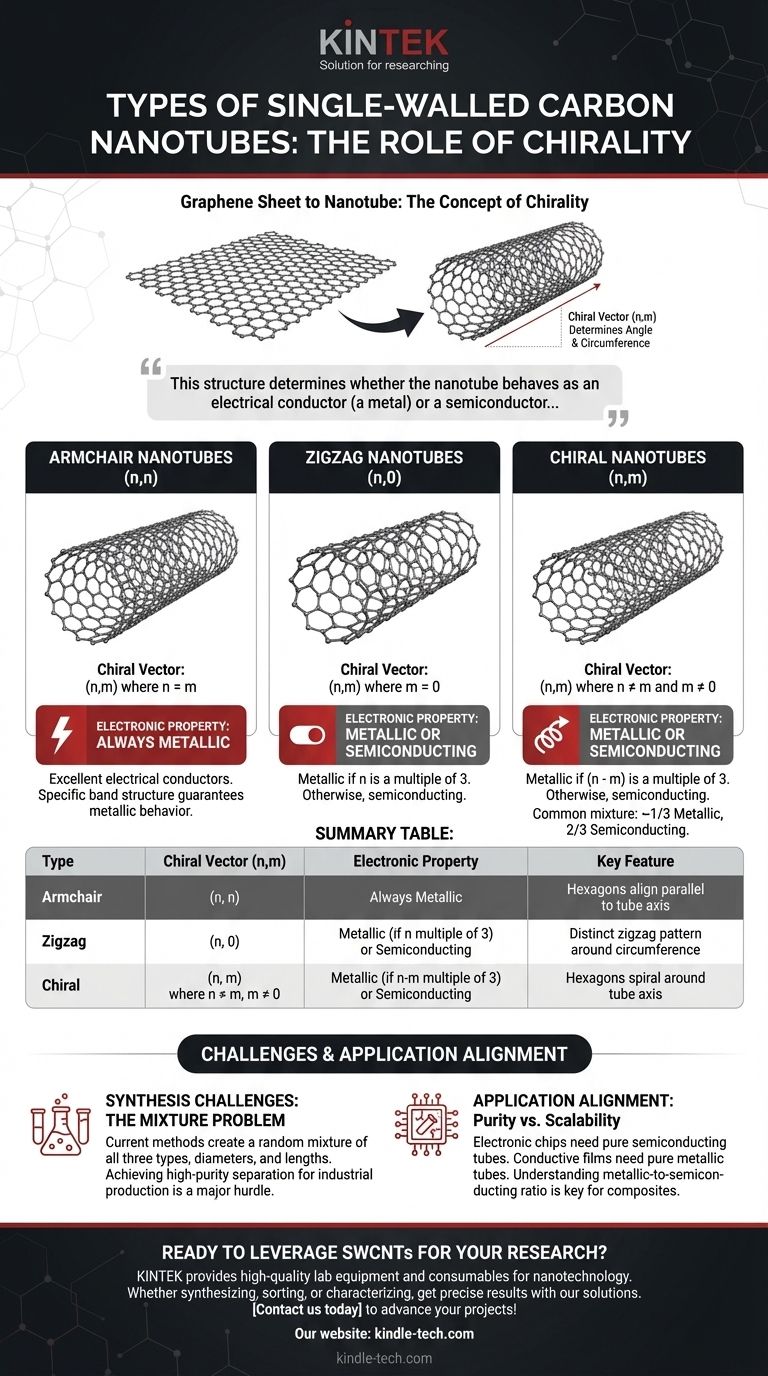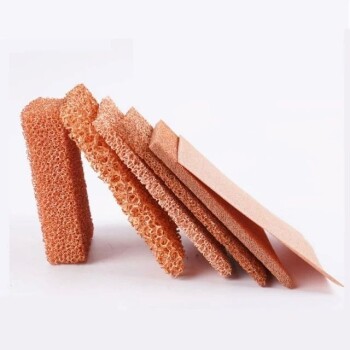At the most fundamental level, single-walled carbon nanotubes (SWCNTs) are categorized into three distinct types based on their atomic structure: Armchair, Zigzag, and Chiral. This structural classification, known as chirality, is determined by how a conceptual sheet of graphene is "rolled" to form the nanotube's cylindrical shape. This seemingly subtle geometric difference is paramount, as it directly dictates the nanotube's most critical electronic properties.
The specific angle at which a carbon nanotube is formed dictates its atomic arrangement (Armchair, Zigzag, or Chiral). This structure, in turn, determines whether the nanotube behaves as an electrical conductor (a metal) or a semiconductor, defining its entire range of potential applications.

The Concept of Chirality: How a Nanotube is Formed
From Graphene to Nanotube
Imagine a single atomic layer of carbon atoms arranged in a honeycomb lattice—this is graphene. A single-walled carbon nanotube is essentially a sheet of this graphene rolled up into a seamless cylinder.
The Chiral Vector (n,m)
The precise way the sheet is rolled is described mathematically by a pair of integers called the chiral vector, denoted as (n,m). These indices define the direction and circumference of the roll, which locks in the nanotube's final atomic structure and properties.
Visualizing the Roll
Think of it like rolling a piece of paper with a honeycomb pattern printed on it. If you roll it straight, the hexagons line up perfectly. If you roll it at an angle, the hexagons will spiral around the tube. The (n,m) vector is the map that defines this exact angle.
The Three Structural Types Explained
Armchair Nanotubes (n,n)
When the indices are equal (n = m), the resulting structure is called Armchair. The hexagons of the carbon lattice align perfectly parallel to the tube's axis, and the opening of the tube resembles a row of armchairs.
This specific atomic arrangement guarantees a certain electronic band structure. As a result, all Armchair SWCNTs are always metallic, behaving as excellent electrical conductors.
Zigzag Nanotubes (n,0)
When one of the indices is zero (m = 0), the structure is called Zigzag. Here, the pattern of carbon bonds forms a distinct zigzag pattern around the circumference of the tube.
Unlike Armchair tubes, Zigzag nanotubes can be either metallic or semiconducting. Their electronic nature depends on the value of 'n': if 'n' is a multiple of 3, they are metallic (or semi-metallic); otherwise, they are semiconducting.
Chiral Nanotubes (n,m)
This is the most general and common category, occurring whenever n ≠ m and m ≠ 0. In a Chiral nanotube, the rows of hexagons spiral or twist around the axis of the tube at a "chiral angle."
Their electrical properties depend on a simple rule: if (n - m) is a multiple of 3, the nanotube is metallic. If not, it is semiconducting. In a typical synthesis, roughly one-third of the resulting SWCNTs are metallic and two-thirds are semiconducting.
Common Pitfalls and Synthesis Challenges
The Mixture Problem
The single greatest challenge in working with SWCNTs is that current synthesis methods (like laser ablation or chemical vapor deposition) do not produce one specific type. Instead, they create a random mixture of Armchair, Zigzag, and Chiral nanotubes with varying diameters and lengths.
The Sorting Imperative
For nearly all high-performance applications, this mixture is unusable. An electronic chip requires purely semiconducting nanotubes, while a transparent conductive film requires purely metallic ones. A single metallic tube in a transistor can create a short circuit and render the device useless.
Purity vs. Scalability
This has driven a massive research effort into post-synthesis separation techniques to sort nanotubes by their electronic type. While highly effective methods exist at the laboratory scale, achieving high-purity separation in an economical, scalable way for industrial production remains a significant hurdle.
Making the Right Choice for Your Application
To effectively use SWCNTs, you must align the nanotube's inherent electronic properties with your end goal.
- If your primary focus is creating conductive pathways or films: You must source or isolate purely metallic SWCNTs. Armchair (n,n) types are the ideal target due to their guaranteed metallic nature.
- If your primary focus is building electronic components like transistors or sensors: You must use high-purity semiconducting SWCNTs. Removing residual metallic tubes from your sample is critical for device performance.
- If your primary focus is enhancing bulk material properties (e.g., in composites): A mixture of types may be sufficient, but understanding the metallic-to-semiconducting ratio is key to predicting the composite's final electrical and thermal conductivity.
Ultimately, understanding the direct link between a nanotube's chiral structure and its electronic destiny is the first principle of applying this remarkable material.
Summary Table:
| Type | Chiral Vector (n,m) | Electronic Property | Key Feature |
|---|---|---|---|
| Armchair | (n, n) | Always Metallic | Hexagons align parallel to tube axis |
| Zigzag | (n, 0) | Metallic (if n multiple of 3) or Semiconducting | Distinct zigzag pattern around circumference |
| Chiral | (n, m) where n ≠ m, m ≠ 0 | Metallic (if n-m multiple of 3) or Semiconducting | Hexagons spiral around tube axis |
Ready to leverage the unique properties of single-walled carbon nanotubes in your research or application? KINTEK specializes in providing high-quality lab equipment and consumables tailored for nanotechnology and materials science. Whether you need support in synthesizing, sorting, or characterizing SWCNTs, our expertise ensures you get the right tools for precise results. Contact us today to discuss how we can help advance your projects with reliable, performance-driven solutions!
Visual Guide

Related Products
- Glassy Carbon Sheet RVC for Electrochemical Experiments
- Copper Foam
- Electron Beam Evaporation Coating Conductive Boron Nitride Crucible BN Crucible
- Silicon Carbide SiC Thermal Heating Elements for Electric Furnace
- Conductive Carbon Fiber Brush for Static Removal and Cleaning
People Also Ask
- What is the proper procedure for cleaning a glassy carbon sheet after use? A Definitive Guide to Ensure Reliable Results
- What is the applicable potential range for an RVC glassy carbon sheet? Master Your Electrochemical Analysis
- What is an RVC glassy carbon sheet? A High-Performance Material for Demanding Applications
- What are the typical physical specifications for glassy carbon sheets? Unlock Superior Performance for Your Lab
- What actions and conditions are strictly prohibited when working with a glassy carbon sheet? Protect Your Investment and Data Integrity



















